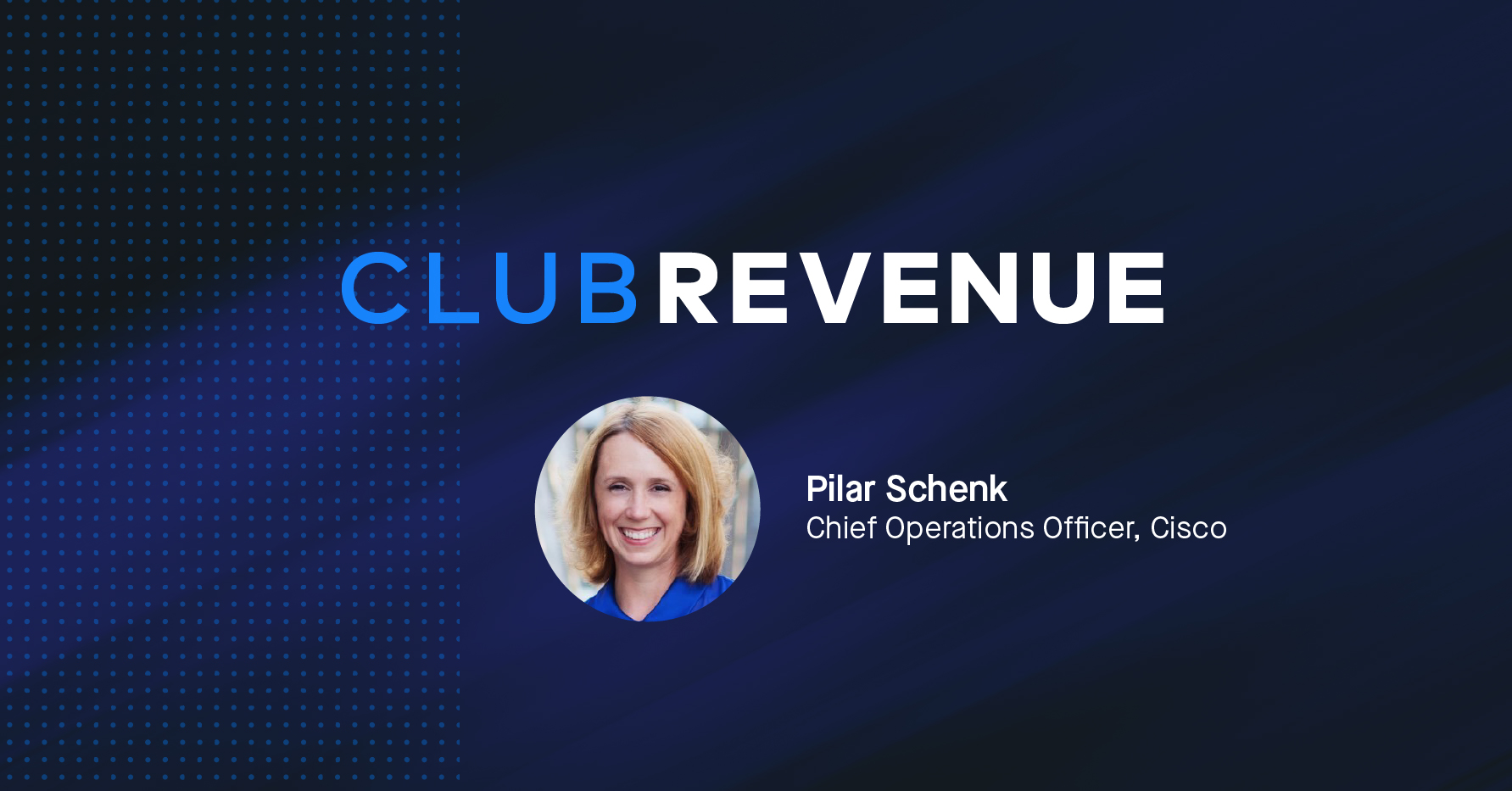The shift to more virtual, remote work in the wake of 2020 has launched new ways to apply digital capabilities—specifically, how companies can harvest all of the data they generate from various business systems and processes to work better, smarter, and faster. And the place where this has the biggest impact? Digital Transformation of Sales using Revenue Operations.
For Pilar Schenk, the Chief Operating Officer of Cisco Collaboration, the answer to transforming her sales process relies on deploying a company-wide revenue operations framework that she calls “the business management system”. Formerly the vice president of sales operations and strategy at McAfee, Schenk joined Cisco in mid-2021 and is building—in her words—”the machinery to operationalize growth”. She’s also a founding member of the Revenue Operations Council.
Schenk joined us on Club Revenue to discuss the emerging trend of revenue operations and its impact. Watch the full episode here:
Schenk is launching into her role at an inflection point. Building the infrastructure that underpins a winning go-to-market strategy is easier today than it was a decade ago. Data is everywhere, and the tools to mine it are smarter and more automated.
Revenue operations is the end-to-end business process of driving predictable revenue, across sales, marketing and customer success. Done right, it delivers visibility, improves efficiency, drives revenue predictability, and achieves unmatched performance and revenue growth.
But the key to a successful digital transformation, and to revenue operations as a whole, isn’t just the technology platform, but how that technology is adopted and applied across the organization.
“There's a lot of great applications out there that help us enable data and put it in the hands of our sellers,” says Schenk. “Now, we have to continue to manage the conversations around alignment. What are the things that are really important, and what are we going to really obsess about?”
End-to-end alignment across a multinational corporation is a tall order, but that synchronization supercharges the revenue engine.
“We can't run north, south, east, and west all at the same time—we end up running nowhere,” she says.
Teams need clarity on strategic priorities
First, revenue operations leaders need to establish clear sales goals and priorities so that they can operationalize them across go-to-market teams.
That may sound obvious, but it’s a deep challenge.
“You have to get very, very specific,” she says. “If these are our strategic priorities, what are the things that we're going to do?”
And then, she continues, how do you know you’re on the right track?
At the end of the quarter or the year, “maybe we get tissues or champagne, depending on how we did.” But sales leaders shouldn’t have to wait until the end of a specific timeframe to gauge their performance. It shouldn’t be a guessing game. This is where digital transformation can make all the difference.
Understanding what works, or doesn’t, along the way requires visibility into real-time revenue data and forecasts, which itself requires everyone to be embedded in the same systems tracking the same KPIs and assessing them at regular cadences.
That is no small ask.
Holdouts? Go courting
On the road to implementing any new revenue strategy or system, there will inevitably be holdouts. Courting their support and changing their behavior is critical to getting everyone moving in the same direction.
Schenk offers five ways to win support.
1. Trust and listen
Gaining buy-in starts with establishing trust and listening to stakeholders. That can mean letting people down the chain set some of the terms on how new processes unfold.
“Every geo-leader, I'm going to them and saying, what cadence do you think we need to meet our goals this year? What meetings do you want? What meetings don't you want?,” she says.
Input not only builds trust, it leads to better outcomes.
“I know that there are blind spots,” she says. For example, “I guarantee you, I don't know what's going on in Japan as well as the Japanese leaders.”
Of course, it would be easy to simply announce decisions, and decree them gospel, but that’s the worst form of influence, says Schenk, because that doesn’t inspire true buy-in.
2. Expect reciprocity
Accountability goes hand in hand with trust.
“If we say these are the things that we want to do and these are the things that are important, and then I give [them] to you, I'm going to expect that you use [them],” says Schenk.
“There are certainly many times where I've had the heart-to-heart,” she continues. “Hey, you asked for this, I gave it to you, but I can tell your team is still doing things in spreadsheets, how do we solve this together?”
3. Develop a sponsorship spine
Especially when it comes to rolling out new tools like Clari, building a “sponsorship spine”—a network of early adopters who can evangelize the tool—is key to widespread adoption. That’s especially true for larger enterprises with revenue teams straddling markets, products, or verticals.
“It's going to be really hard for me to advocate for [technology] from afar,” explains Schenk. “I'm not part of their team, I'm not in their day-to-day business. But if I have someone in that business who knows it really well and can advocate... people will come on board.”
This extends to executives, too.
When you make the investment in a new tool, use it, and use it publicly.
4. Play hardball if you have to
In the worst case scenario, you may have to make adoption a condition of collaboration.
At McAfee, before Clari was implemented, “they had done everything in spreadsheets and the forecast was kind of on the back of napkins,” says Schenk. “And people would go all over the place, or worse, they would come in with a spreadsheet” to meetings.
Schenk resolved to end any calls where sales and revenue leaders brought their own spreadsheets, instead of the new revenue operations platform. Ending the calls meant she was halting the conversation, a way of calling them out.
“It was kind of embarrassing for their leaders that came in, but I can tell you that it didn't happen again after that,” she says. “And we had great hygiene in our CRM and our pipeline because of it.”
5. Go forward in lockstep
Once you have alignment around goals, and adoption of the systems operationalizing those goals, you have the groundwork for building a path together toward a shared north star, also known as the shared source of truth.
Getting there isn’t easy. But, Schenk says, doing so pays dividends down the line.
“I think it's a big mistake [that] a lot of times management systems don't take the hard, long time to sharpen that ax, the hard conversations we have early on to say what truly is important,” she says.
Watch Club Revenue
Club Revenue is Clari’s new video series on Nasdaq, airing bi-weekly beginning October 26. Tune into our next episode, where Divvy’s CRO, Sterling Snow, shares his winning strategy for maximizing revenue by bringing marketing and sales into a true partnership.
Read more:




